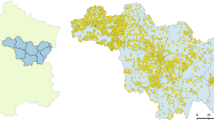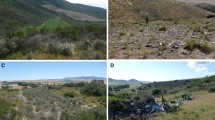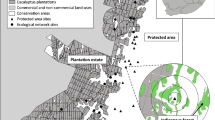Abstract
Conversion of terrestrial land for the purposes of agriculture and urban development continues to result in loss and fragmentation of natural habitats. In this study, we focus on butterflies and investigate the relative importance of landscape-level habitat amount (the proportion of woodland area within a landscape), habitat fragmentation (length of woodland edges within a landscape), urbanization (the proportion of urban area within a landscape), and local host plant diversity for butterfly communities in a fragmented landscape in Hokkaido, northern Japan. Butterfly species observed in the field were grouped into woodland and open-land species. The results showed that both landscape and local factors shape the butterfly community. At a landscape-scale, woodland butterflies positively responded to woodland area and negatively to edge density, whereas open-land butterflies showed opposite responses. At a local-scale, positive influences of local host plant diversity on woodland butterflies were evident, but not for open-land species. These results suggest that negative influences of anthropogenic land-use changes on biodiversity could be mitigated by strategies aimed at stopping the spread of woodland edges and providing a wide variety of different host plant species in the landscape. Unfortunately, this study implies that further increases in habitat loss and fragmentation and decline in host plant diversity lead to a homogenization of local biological communities and functions.



Similar content being viewed by others
References
Barton K (2012) MuMIn: multi-model inference. http://cran.r-project.org/web/packages/MuMIn/
Bates D, Maechler M, Bolker B (2013) lme4: linear mixed-effects models using Eigen and S4. R package version 1.0–4. http://CRAN.R-project.org/package=lme4
Bergman KO, Ask L, Askling J, Ignell H, Wahlman H, Milberg P (2008) Importance of boreal grasslands in Sweden for butterfly diversity and effects of local and landscape habitat factors. Biodivers Conserv 17:139–153
Bonnington C, Gaston KJ, Evans KL (2013) Fearing the feline: domestic cats reduce avian fecundity through trait-mediated indirect effects that increase nest predation by other species. J Appl Ecol 50:15–24
Burgess VJ, Kelly D, Robertson AW, Ladley JJ (2006) Positive effects of forest edges on plant reproduction: literature review and a case study of bee visitation to flowers of Peraxilla tetrapetala (Loranthaceae). NZ J Ecol 30:179–190
Burnham KP, Anderson DR (2002) Model selection and multimodel inference: a practical information-theoretic approach, 2nd edn. Springer, New York
Cobbold SM, Supp SR (2012) Patch shape alters spider community structure: links between microhabitat choice and sensitivity to increased edge habitat. J Insect Conserv 16:581–589
Collinge SK, Prudic KL, Oliver JC (2003) Effects of local habitat characteristics and landscape context on grassland butterfly diversity. Conserv Biol 17:178–187
Concepción ED, Moretti M, Altermatt F, Nobis MP, Obrist MK (2015) Impacts of urbanisation on biodiversity: the role of species mobility, degree of specialisation and spatial scale. Oikos. doi:10.1111/oik.02166
Cook WM, Lane KT, Foster BL, Holt RD (2002) Island theory, matrix effects and species richness patterns in habitat fragments. Ecol Lett 5:619–623
Devictor V, Julliard R, Couvet D, Lee A, Jiguet F (2007) Functional homogenization effect of urbanization on bird communities. Conserv Biol 21:741–751
Endo S, Nihira I (1990) Larval food of Japanese butterflies. Group Tamamushi, Tokyo
Ewers RM, Didham RK (2006) Confounding factors in the detection of species responses to habitat fragmentation. Biol Rev 81:117–142
Ewers RM, Didham RK (2007) The effect of fragment shape and species’ sensitivity to habitat edges on animal population size. Conserv Biol 21:926–936
Fahrig L (2002) Effect of habitat fragmentation on the extinction threshold: a synthesis. Ecol Appl 12:346–353
Fahrig L (2003) Effects of habitat fragmentation on biodiversity. Ann Rev Ecol Evol Syst 34:487–515
Fischer J, Lindenmayer DB (2007) Landscape modification and habitat fragmentation: a synthesis. Glob Ecol Biogeogr 16:265–280
Flick T, Feagan S, Fahrig L (2012) Effects of landscape structure on butterfly species richness and abundance in agricultural landscapes in eastern Ontario, Canada. Agric Ecosyst Environ 156:123–133
Fred MS, Brommer JE (2003) Influence of habitat quality and patch size on occupancy and persistence in two populations of the Apollo butterfly (Parnassius apollo). J Insect Conserv 7:85–98
Fukuda H, Hama E, Kuzuya T, Takahashi A, Tahakashi M, Tanaka B, Tanaka H, Wakabayashi M, Watanabe Y (1982) The life histories of butterflies in Japan, vol I. Hoikusha, Osaka
Fukuda H, Hama E, Kuzuya T, Takahashi A, Tahakashi M, Tanaka B, Tanaka H, Wakabayashi M, Watanabe Y (1983) The life histories of butterflies in Japan, vol II. Hoikusha, Osaka
Fukuda H, Hama E, Kuzuya T, Takahashi A, Tahakashi M, Tanaka B, Tanaka H, Wakabayashi M, Watanabe Y (1984a) The life histories of butterflies in Japan, vol III. Hoikusha, Osaka
Fukuda H, Hama E, Kuzuya T, Takahashi A, Tahakashi M, Tanaka B, Tanaka H, Wakabayashi M, Watanabe Y (1984b) The life histories of butterflies in Japan, vol IV. Hoikusha, Osaka
Hodgson P, French K, Major RE (2007) Avian movement across abrupt ecological edges: differential responses to housing density in an urban matrix. Landsc Urban Plan 79:266–272
Kitahara M, Yumoto M, Kobayashi T (2008) Relationship of butterfly diversity with nectar plant species richness in and around the Aokigahara primary woodland of Mount Fuji, central Japan. Biodivers Conserv 17:2713–2734
Krämer B, Poniatowski D, Fartmann T (2012) Effects of landscape and habitat quality on butterfly communities in pre-alpine calcareous grasslands. Biol Conserv 152:253–261
Krauss J, Steffan-Dewenter I, Tscharntke T (2003) How does landscape context contribute to effects of habitat fragmentation on diversity and population density of butterflies? J Biogeogr 30:889–900
Krauss J, Steffan-Dewenter I, Müller CB, Tscharntke T (2005) Relative importance of resource quantity, isolation and habitat quality for landscape distribution of a monophagous butterfly. Ecography 28:465–474
Magura T, Tóthmérész B, Molnár T (2008) A species-level comparison of occurrence patterns in carabids along an urbanisation gradient. Landsc Urban Plan 86:134–140
McKinney ML (2008) Effects of urbanization on species richness: a review of plants and animals. Urban Ecosyst 11:161–176
Merckx T, Marini L, Feber RE, Macdonald DW (2012) Hedgerow trees and extended-width field margins enhance macro-moth diversity: implications for management. J Appl Ecol 49:1396–1404
Newport J, Shorthouse DJ, Manning AD (2014) The effects of light and noise from urban development on biodiversity: implications for protected areas in Australia. Ecol Manag Restor 15:204–214
Öckinger E, Smith HG (2006) Landscape composition and habitat area affects butterfly species richness in semi-natural grasslands. Oecologia 149:526–534
Öckinger E, Dannestam Å, Smith HG (2009) The importance of fragmentation and habitat quality of urban grasslands for butterfly diversity. Landsc Urban Plan 93:31–37
Ozaki K, Isono M, Kawahara T, Iida S, Kudo T, Fukuyama K (2004) Habitat classifications of butterflies based on the differences in butterfly communities in woodlands and open lands in central Hokkaido, Japan. J Japanese Forest Soc 86:251–257
R Core Team (2013) R: A language and environment for statistical computing. R Foundation for Statistical Computing, Vienna, Austria. http://www.R-project.org/
Reino L, Beja P, Araujo MB, Dray S, Segurado P (2013) Does local habitat fragmentation affect large-scale distributions? The case of a specialist grassland bird. Divers Distrib 19:423–432
Ries L, Debinski DM (2001) Butterfly responses to habitat edges in the highly fragmented prairies of Central Iowa. J Anim Ecol 70:840–852
Schmitt T, Varga Z, Seitz A (2000) Forests as dispersal barriers for Erebia medusa (Nymphalidae, Lepidoptera). Basic Appl Ecol 1:53–59
Seto KC, Güneralp B, Hutyra LR (2012) Global forecasts of urban expansion to 2030 and direct impacts on biodiversity and carbon pools. Proc Nat Acad Sci USA 109:16083–16088
Shanahan DF, Possingham HP (2009) Predicting avian patch occupancy in a fragmented landscape: do we know more than we think? J Appl Ecol 46:1026–1035
Soga M, Koike S (2012) Relative importance of quantity, quality and isolation of patches for butterfly diversity in fragmented urban forests. Ecol Res 27:265–271
Soga M, Koike S (2013) Patch isolation only matters for specialist butterflies but patch area affects both specialist and generalist species. J Forest Res 18:270–278
Soga M, Kanno N, Yamaura Y, Koike S (2013) Patch size determines the strength of edge effects on carabid beetle assemblages in urban remnant forests. J Insect Conserv 17:421–428
Soga M, Yamaura Y, Koike S, Gaston KJ (2014a) Land sharing versus land sparing: Does the compact city reconcile urban development and biodiversity conservation? J Appl Ecol 51:1378–1386
Soga M, Yamaura Y, Koike S, Gaston KJ (2014b) Woodland remnants as an urban wildlife refuge: a cross-taxonomic assessment. Biodivers Conserv 23:649–659
Sutherland RW, Dunning PR, Baker WM (2010) Amphibian encounter rates on roads with different amounts of traffic and urbanization. Conserv Biol 24:1626–1635
Tanaka B (1988) A method of environmental evaluation by means of faunal composition of butterflies. Spec Bull Lepid Soc Jpn 6:527–566
Thomas JA, Simcox DJ, Hovestadt T (2011) Evidence based conservation of butterflies. J Insect Conserv 15:241–258
Yamaura Y, Kawahara T, Iida S, Ozaki K (2008) Relative importance of the area and shape of patches to the diversity of multiple taxa. Conserv Biol 22:1513–1522
Ye X, Skidmore AK, Wang T (2013) Within-patch habitat quality determines the resilience of specialist species in fragmented landscapes. Landsc Ecol 28:135–147
Acknowledgments
We thank G. Takao and T. Sakai for permission and assistance in analyzing the land-use map and Y. Yamaura for helpful discussion. R.C. Johns kindly edited the English. This study was supported by JSPS KAKENHI Grant Number 25252030.
Author information
Authors and Affiliations
Corresponding author
Electronic supplementary material
Below is the link to the electronic supplementary material.
Rights and permissions
About this article
Cite this article
Soga, M., Kawahara, T., Fukuyama, K. et al. Landscape versus local factors shaping butterfly communities in fragmented landscapes: Does host plant diversity matter?. J Insect Conserv 19, 781–790 (2015). https://doi.org/10.1007/s10841-015-9799-9
Received:
Accepted:
Published:
Issue Date:
DOI: https://doi.org/10.1007/s10841-015-9799-9




